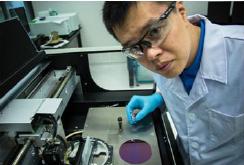Breakthrough in producing MoS2 flakes
The breakthrough makes use of metal adducts of naphthalene and through a two-step expansion and intercalation method, the researchers were able to produce high quality single-layer MoS2 sheets with large flake size. The exfoliated MoS2 flakes can then be easily made into a printable solution. By using the inkjet printing technique, ultra-thin MoS2 films can be printed on silicon substrates. Also, this technique can be applied to other two-dimensional chalcogenides, such as tungsten diselenide and titanium disulfide, with high yields.
Printable ink for optoelectronic devices
Moving forward, Prof Loh and his team will be actively developing printable inks made by exfoliating different types of two-dimensional chalcogenides and explore their suitability for producing printable optoelectronic devices. The NUS team collaborated with scientists from the Ulsan National Institute of Science and Technology in Korea for this research work, and these findings were first published online in the scientific journal Nature Communications in January 2014.

Zheng Jian, the first author of the paper, demonstrating the printing of Molybdenum Disulfide (MoS2) flakes from a solution of the exfoliated flakes.
[Image source: Office of Corporate Relations, NUS]


